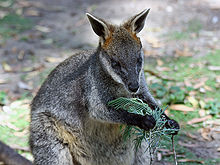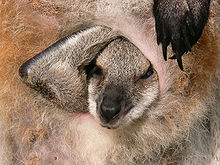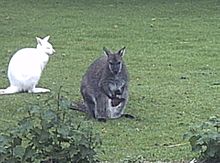
Wallaby
Did you know...
SOS believes education gives a better chance in life to children in the developing world too. SOS Children has looked after children in Africa for forty years. Can you help their work in Africa?
A wallaby is any of about thirty species of Macropodidae family. It is an informal designation generally used for any macropod that is smaller than a kangaroo or wallaroo that has not been designated otherwise.
Overview
Forest-dwelling wallabies are known as " pademelons" (genus Thylogale) and "dorcopsises" (genera Dorcopsis and Dorcopsulus). The name "wallaby" comes from the Eora, who were the first human inhabitants of the Sydney area. Young wallabies are known as " joeys", like many other marsupials. Adult male wallabies are referred to as "bucks", "boomers", or "jacks". An adult female wallaby is known as a "doe", "flyer", or "jill". A group of wallabies is called a "court", "mob", or "troup". Although members of most wallaby species are small, some can grow up to six feet in length (from head to tail).
Wallabies are herbivores whose diet consists of a wide range of grasses, vegetables, leaves, and other foliage. Due to recent urbanization, many wallabies now feed in rural and urban areas. Wallabies cover vast distances for food and water, which is often scarce in their environment. Mobs of wallabies often congregate around the same water hole during the dry season.
Their powerful hind legs are not only used for bounding at high speeds and jumping great heights, but also to administer vigorous kicks to fend off potential predators. Wallabies also have a powerful tail that is used mostly for balance and support.
Wallabies face several threats. Wild dogs, foxes, and feral cats are among the predators they face. Humans also pose a significant threat to wallabies due to increased interaction. Many wallabies have been involved in vehicular accidents as they often feed near roads and urban areas.
Classification
Wallabies are not a distinct genetic group. Nevertheless, they fall into several broad categories. Typical wallabies of the genus Macropus, like the agile wallaby (Macropus agilis), and the red-necked wallaby (Macropus rufogriseus) are most closely related to the kangaroos and wallaroos and, size aside, look very similar. These are the ones most frequently seen, particularly in the southern states.
Rock-wallabies (genus Petrogale), rather like the goats of the northern hemisphere, specialise in rugged terrain and have modified feet adapted to grip rock with skin friction rather than dig into soil with large claws. There are at least fifteen species and the relationship between several of them is poorly understood. Several are endangered. Captive rock wallaby breeding programs like the one at Healesville Sanctuary have had some success and a small number have recently been released into the wild.
The banded hare-wallaby (Lagostrophus fasciatus) is thought to be the last remaining member of the once-numerous subfamily Sthenurinae, and although once common across southern Australia, is now restricted to two islands off the Western Australian coast which are free of introduced predators. It is not as closely related to the other hare wallabies (genus Lagorchestes) as the hare wallabies are to the other wallabies.
New Guinea, which was until fairly recent geological times part of mainland Australia, has at least five species of wallaby.
Natural range and habitat
Wallabies are widely distributed across Australia, particularly in more remote, heavily timbered, or rugged areas, less so on the great semi-arid plains that are better suited to the larger, leaner, and more fleet-footed kangaroos. They also can be found at the island of New Guinea
Introduced populations
Wallabies of several species have been introduced to other parts of the world, and there are a number of breeding feral populations, including:
- Kawau Island in New Zealand is home to large numbers of tammar, Parma, swamp and brush-tailed rock-wallaby from introductions made around 1870. They are considered a pest on the island, but a programme to re-introduce them to Australia has met with only limited success.
- The Lake Tarawera area of New Zealand has a large tammar population.
- The South Canterbury district of New Zealand has a large population of Bennett's wallaby.
- On the Isle of Man in the Ballaugh Curraghs area, there is a feral population of over 100 bred originally from a pair that escaped from the nearby Curraghs Wildlife Park in 1970.
- Hawaii has small feral population of wallabies in the upper regions of Kalihi Valley of the island of Oahu arising from an escape of zoo specimens of brush-tailed rock-wallaby (Petrogale penicillata) in 1916.
- In the Peak District of England, a population was established in around 1940 by five escapees from a local zoo, and as of late March 2009 sightings were still being made in the area. At its peak in 1975 the population numbered around sixty individuals.
- The island of Inchconnachan in Loch Lomond, Scotland, has a population of around 28 red-necked wallabies introduced by Lady Colquhoun in the 1920s. Eradication to protect the native capercaillie has been proposed.
- There is also a small population on Lambay Island off the east coast of Ireland. This group was introduced by Dublin Zoo after a sudden population explosion in the mid 1980s.
- Other populations in the United Kingdom that for some periods bred successfully included one near Teignmouth, Devon, another in the Ashdown Forest, East Sussex and one on the island of Bute and Lundy. It has recently been reported by walkers in the Lickey Hills Country Park area of Birmingham that a pair of wallabies have been released or are loose there (East Tunnock Rambling Club Meeting, December 2010).
- In France, in the southern part of the Forest of Rambouillet, 50 kilometres west of Paris, there is a wild group of around 30 Bennett's wallabies. This population has been present since the seventies, when some individuals escaped from the zoological park of Émancé after a storm.
Species

As mentioned above, the term wallaby is not well defined and can mean just about any macropod of moderate size. In consequence, the listing below is arbitrary and taken from the complete list of macropods.
- Agile wallaby, Macropus agilis
- Allied rock-wallaby, Petrogale assimilis
- Banded hare-wallaby, Lagostrophus fasciatus
- Black dorcopsis, Dorcopsis atrata
- Black-flanked rock-wallaby, Petrogale lateralis
- Black-striped wallaby, Macropus dorsalis
- Bridled nail-tail wallaby, Onychogalea fraenata
- Brown dorcopsis, Dorcopsis muelleri
- Brown's pademelon, Thylogale browni
- Brush-tailed rock-wallaby, Petrogale penicillata
- Calaby's pademelon, Thylogale calabyi
- Cape York rock-wallaby, Petrogale coenensis
- Crescent nail-tail wallaby, Onychogalea lunata (extinct)
- Dusky pademelon, Thylogale brunii
- Eastern hare-wallaby, Lagorchestes leporides (extinct)
- Godman's rock-wallaby, Petrogale godmani
- Gray dorcopsis, Dorcopsis luctuosa
- Herbert's rock-wallaby, Petrogale herberti
- Lake Mackay hare-wallaby, Lagorchestes asomatus (extinct)
- Macleay's dorcopsis, Dorcopsulus macleayi
- Mareeba rock-wallaby, Petrogale mareeba
- Monjon, Petrogale burbidgei
- Mt. Claro rock-wallaby, Petrogale sharmani
- Mountain pademelon, Thylogale lanatus
- Nabarlek, Petrogale concinna
- Northern nail-tail wallaby, Onychogalea unguifera
- Parma wallaby, Macropus parma (rediscovered, thought extinct for 100 years)
- Whiptail wallaby, Macropus parryi
- Proserpine rock-wallaby, Petrogale persephone
- Purple-necked rock-wallaby, Petrogale purpureicollis
- Red-legged pademelon, Thylogale stigmatica
- Red-necked pademelon, Thylogale thetis
- Red-necked wallaby, Macropus rufogriseus
- Rothschild's rock-wallaby, Petrogale rothschildi
- Rufous hare-wallaby, Lagorchestes hirsutus
- Short-eared rock-wallaby, Petrogale brachyotis
- Swamp wallaby or Black Wallaby, Wallabia bicolor
- Tammar wallaby, Macropus eugenii
- Tasmanian pademelon, Thylogale billardierii
- Toolache wallaby, Macropus greyii (extinct)
- Unadorned rock-wallaby, Petrogale inornata
- Western brush wallaby, Macropus irma
- White-striped dorcopsis, Dorcopsis hageni
- Yellow-footed rock-wallaby, Petrogale xanthopus





